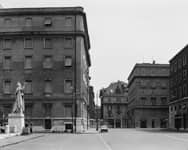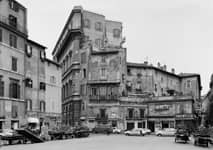Compared with the German cities he knew, the historically intact and multi-layered urban environment of Rome left a deep impression on Struth. Rome was the first city Struth travelled to after completing his civilian service in Germany. He prepared for the trip by making a resume of his work to date in the form of small prints gathered in albums: one each on the central perspective photographs from New York City and the Düsseldorf street photographs; one on other European cities, the Beaugrenelle project in Paris and the Tower Hamlets project with Axel Hütte in London. In reviewing his work to date, Struth realised that the central perspective was no longer imperative, and that he could ‘see analytically’ without needing a single overarching structure or compositional device.
Visiting Rome in 1984 felt like a new starting point for Struth. He stayed with his friend and former fellow student Janice Guy who had also been at the Kunstakademie and had subsequently moved to Rome.
Struth’s thinking at the time was influenced by a book he had read in the mid-1970s as part of his philosophy studies at the Kunstakademie, Wolfgang Köhler’s Gestalt Psychology (Psychologische Probleme), first published in 1929. Köhler’s book contained a detailed analysis of the dynamics of perception and argued that no single phenomenon could be evaluated in an isolated way. “The idea that everything is interrelated, that it is always the dynamic between the different elements which creates information, the ‘reality’ of what one can see” profoundly influenced the way Struth constructed his city photographs.
As in his earlier city work in Düsseldorf and New York, he chose to photograph in everyday urban environments as opposed to more well-known or touristic locations. He looked for places in the city where the elements would work together in a very precise way.


